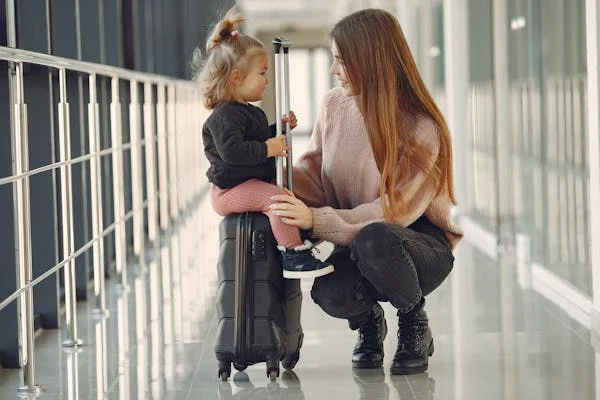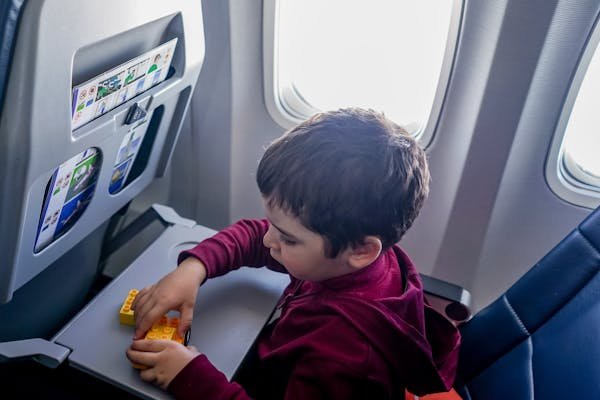The holiday season brings joy, excitement, and often, the necessity to travel. For parents, flying with kids can be one of the most daunting aspects of holiday plans. The combination of crowded airports, long security lines, and the challenge of keeping children entertained on a flight can make the journey seem overwhelming. However, with a little preparation and the right strategies, flying with kids can be a smooth and even enjoyable experience. This comprehensive guide offers practical tips for flying with kids, covering everything you need to know from preparation to arrival.
Pre-Flight Preparations When flying with kids
1. Choose the Right Flight
When flying with kids, the timing of your flight can make a significant difference. Consider the following:
- Non-stop flights: Opt for direct flights whenever possible to avoid the hassle of changing planes and the risk of delays.
- Flight times: Early morning flights are often less crowded and more likely to be on time. Additionally, aligning flight times with your child’s nap schedule can result in a more peaceful journey.
2. Book Seats in Advance
Ensure you have assigned seats together. Many airlines allow you to select seats during the booking process or shortly after. If you have infants or toddlers, consider bulkhead seats that offer extra space for bassinets.
3. Prepare Travel Documents
Ensure you have all necessary travel documents well in advance. This includes passports, visas, and any required identification for your children. Some airlines require proof of age for infants and toddlers, so bring a copy of their birth certificates.
4. Pack Smartly

When packing for flying with kids, think strategically. Here’s a checklist of essentials:
Carry-On Bag: Pack a bag with essentials for each child. This should include:
- Diapers, wipes, and a changing pad for infants and toddlers.
- A change of clothes for each child.
- Snacks and meals that are easy to manage and won’t create a mess.
- Comfort items such as blankets, pacifiers, and favorite toys.
- Headphones, tablets, and portable chargers.
- A small first-aid kit with band-aids, antiseptic wipes, and any necessary medications.
Checked Luggage: Be mindful of weight limits and try to pack efficiently. Use packing cubes to organize clothes and keep items easily accessible.
At the Airport-When flying with kids

1. Arrive Early
Give yourself plenty of time to navigate the airport. Arriving early reduces stress and allows for unexpected delays, such as long lines at check-in or security.
2. Use Family Lanes
Many airports have designated family lanes at security checkpoints. These lanes are typically less crowded and the staff is more accustomed to dealing with families.
3. Take Advantage of Airport Amenities
Airports often have play areas and family-friendly lounges. Let your kids burn off some energy before boarding. Some airports even offer special services for families, such as priority boarding or stroller rentals.
On the Plane-When flying with kids
1. Boarding the Flight
Take advantage of pre-boarding if offered. This allows you to get settled without the rush of other passengers. If pre-boarding is not available, consider boarding last to minimize the time your child has to sit on the plane.
2. Seating Arrangements
Once on the plane, get your children comfortable and organized. Have essential items like snacks, toys, and electronics within easy reach.
3. Keep Them Entertained

Keeping children entertained during the flight is crucial. Here are some tips:
- Tablets and Headphones: Load tablets with movies, TV shows, and games. Don’t forget child-sized headphones.
- Books and Coloring Supplies: Bring a few favorite books and coloring supplies. Sticker books can also be a hit.
- Interactive Toys: Small toys that can be played with quietly and don’t have small parts are ideal. Magnetic games and puzzles work well.
4. Snacks and Meals
Bring a variety of snacks and meals that your children enjoy. Avoid sugary treats that can lead to hyperactivity. Pack items that are easy to eat and won’t make a mess.
5. Comfort Items
Having familiar comfort items like blankets, stuffed animals, or pacifiers can help soothe and calm your child, especially during takeoff and landing.
6. Manage Expectations
Explain the flight process to your children in advance. Let them know what to expect, including the need to stay seated and wear seat belts.
Arriving at Your Destination- flying with kids
1. Gather Your Belongings
Ensure you have all your belongings, especially items that may have rolled under seats. Double-check the overhead bins and seat pockets.
2. Plan for Ground Transportation
Arrange for child-friendly ground transportation in advance. Many car services offer car seats, or you may need to bring your own.
3. Adjust to the New Environment
Allow your children some time to adjust to the new environment once you arrive. If you’re staying in a hotel, set up a familiar sleeping area with their blankets and comfort items.
Additional Tips for Flying with Kids
1. Dress Comfortably
Dress your children in comfortable layers. Airplane temperatures can vary, and layers make it easy to adjust.
2. Be Patient and Flexible
Traveling with kids requires patience and flexibility. Expect the unexpected and remain calm. Your attitude can significantly influence your child’s behavior.
3. Keep Important Items Accessible
Always have essential items like medications, documents, and comfort items within easy reach. Avoid placing these items in checked luggage.
4. Plan for Delays
Delays are often unavoidable. Have a plan to keep your children occupied during unexpected waits.
5. Stay Positive
Maintaining a positive attitude can help make the experience more enjoyable for everyone. Celebrate the small victories and enjoy the journey.
What Do You Need When Flying with Kids?
1. Essential Documents
- Passports, visas, and identification
- Birth certificates (if required)
2. Packing List
- Diapers, wipes, and changing pad
- Change of clothes
- Snacks and meals
- Comfort items (blankets, toys)
- Entertainment (tablets, books)
- First-aid kit and medications
3. Health and Safety Items
- Hand sanitizer and disinfecting wipes
- Ear pressure relief items (pacifiers, gum)
- Hydration supplies
- Motion sickness remedies
4. Travel Gear
- Car seats or booster seats (if required)
- Strollers
- Baby carriers
Your carry-on should include essentials such as diapers, wipes, a change of clothes, snacks, comfort items (like blankets or stuffed animals), entertainment (tablets, books, toys), and a small first-aid kit with medications. Ensure all important documents are also easily accessible.
Bring a variety of entertainment options like tablets pre-loaded with movies and games, child-friendly headphones, books, coloring supplies, and small interactive toys. Mixing up activities can keep them engaged throughout the flight.
To alleviate ear pressure, encourage your child to chew gum, suck on a pacifier, or drink from a bottle during takeoff and landing. Older kids can try yawning or swallowing frequently.
Early morning flights are typically less crowded and more likely to depart on time. Scheduling flights during nap times or overnight can also be beneficial, as children might sleep through the journey.
Pack extra snacks, drinks, and activities to keep your children occupied. Bring portable chargers for electronic devices and ensure comfort items like blankets and stuffed animals are accessible. Staying patient and flexible is key to managing delays smoothly.
